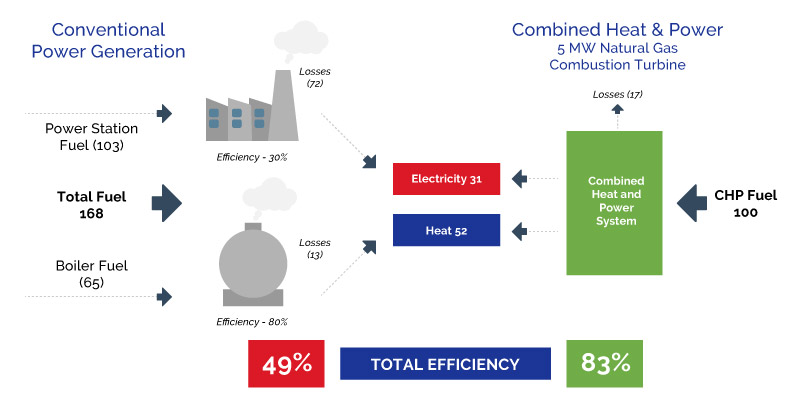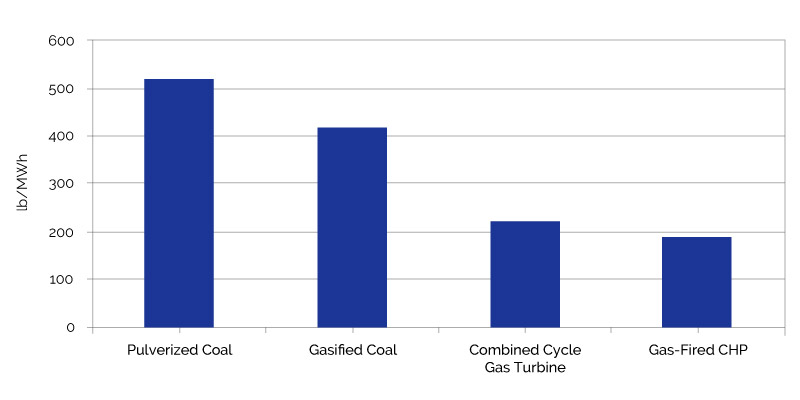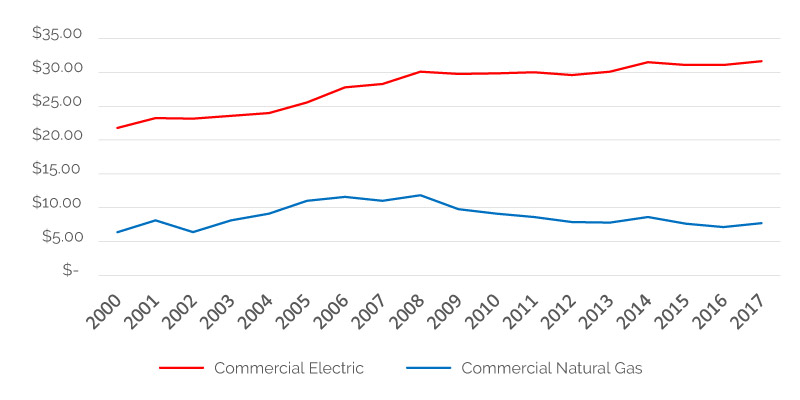2.1 Benefits of CHP
CHP provides many benefits compared to separate heat and power production. These benefits include increased energy efficiency, operating cost savings, and reduced air pollution. This section describes and quantifies these benefits for the existing and remaining CHP potential. There are additional benefits for industry including increased reliability, power quality, and higher productivity. The electric power industry and its customers can also benefit CHP capacity is used to support and optimize the overall power grid.
2.1 Energy Benefits
Combined Heat & Power systems creates large amounts of heat in the process of converting fuel into electricity. For the average central utility power plant, approximately two thirds of the energy content of the input fuel is converted to heat and wasted. As an alternative, an end-user with significant thermal and power needs can simultaneously generate both its thermal and electrical energy in a CHP system located at or near its facility. CHP can significantly increase the efficiency of energy utilization as shown in Figure 2-1.
The figure shows that a typical CHP system can reduce energy requirements by 40 percent compared to separate production of heat and power. For 100 units of input fuel, CHP converts 83 units to useful energy of which 31 units are electricity and 52 units are for steam or hot water. Traditional separate heat and power components require 168 units of energy to accomplish the same end use tasks.
CHP Efficiencies

Figure 2-1
2.2 Environmental Benefits
By increasing energy efficiency, CHP significantly reduces emissions of criteria pollutants such as NOx and SO2 , and other greenhouse gases such as CO2 . CHP is an option that can provide environmental benefits as part of an economically attractive investment. Figure 2-2 shows CO2 emission comparisons respectively by power generation technology and fuel type. CHP technologies can significantly reduce emissions and compare favorably to advanced low emission central station technologies such as gas-fired combined cycle systems.
Carbon Emissions

Figure 2-2 – Source EIA
EPA’s CHP Emissions Calculator calculates the difference between the anticipated carbon dioxide (CO2), methane (CH4), nitrous oxide (N2O), sulfur dioxide (SO2), and nitrogen oxide (NOx) emissions of a CHP system and those of grid-supplied electricity and an on-site boiler. The calculator uses fuel specific emissions factors developed by EPA, and grid emissions factors and region-specific transmission and distribution (T&D) loss data from eGrid. This tool can be found at: https://www.epa.gov/chp/chp-emissions-calculator
2.3 Economic Benefits
The primary economic driver for CHP & DG is the production of power at rates that are lower than the utility’s delivered price. Figure 2-3 shows the historical and projected retail price of electric and natural gas for commercial customers converted to common units of $/MMBTU. It isn’t difficult to see a trend where electric at the point of use costs approximately 3X that of natural gas.
Average Retail Commercial U.S. Energy Prices including Short Term EIA Outlook ($/MMBTU)

Figure 2-3 – Source EIA
Figure 2-4 shows a simple life cycle cost analysis for 3 different 1000 KW CHP systems compared to continuing to purchase power from the grid. It can be seen that the capital costs for the CHP system, operating and maintained costs and energy costs projected out over the expected 20 year life of the equipment are far lower for CHP systems than the ‘do nothing’ scenario where a facility continues to purchase all its power from the electric utility and gas for heating & water heating from the gas utility.
CHP Options Compared to Purchased Electricity
2.4 Ancillary Benefits
In a restructured power market, DG, CHP and other on-site generation options can offer grid support to the local distribution utility. On-site generation can offer ancillary benefits to the grid including:
- Voltage and frequency support to enhance reliability and power quality
- Avoidance or deferral of high cost, long lead time T&D upgrades
- Bulk power risk management
- Reduced line losses, reactive power control
- Outage cost savings
- Reduced central station generating reserve requirements
- Transmission capacity release
DG and CHP offers a customer enhanced reliability, operational and load management flexibility, ability to arbitrage electric and gas prices, and energy management techniques including peak shaving and thermal energy storage. The value of these benefits depends on the characteristics of the facility, energy use and prices, load profiles, and electric rate tariffs, etc. A DG or CHP investment should consider the possible ancillary benefits including the revenue stream from sale of T&D benefits to the independent system operator (or equivalent) and reduced operating costs, along with the other costs and benefits of the project.
